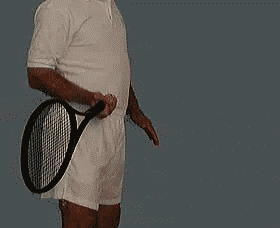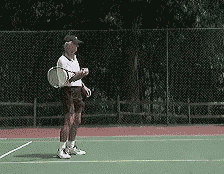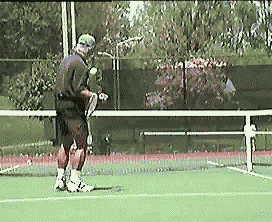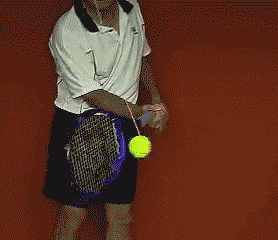|
TennisOne Lessons
From Push to Punch
You have often heard someone say "I can't stand playing him because he is a pusher." The term "pusher" is usually not used politely by many players and the concept brings forth such strong emotions that we decided to take a close look at pushers to see if science could shed some light on them
and to discover how you can evolve from being a pusher to a puncher." What this means is that the path of the racquet between a push and a strike or punch may be very similar, but the velocity along the path varies dramatically. To illustrate these differences, we decided to replicate both strokes, video them, and then construct an overlay of the two in order to illustrate what is happening, and why.
By reviewing the video above you will see that the two motions can be very similar, as we have said, at the professional level. However, the push is a fairly constant motion through all stages of the stroke whereas the punch is slow through the contract and rotate stages and very fast by the end of the acceleration stage, leading to a high power strike stage. This is a key characteristic of the difference between the two motions. Comparing the push to the punch using a professional stroke allows us to see the key differences between the two motions. But, there are pushing motions that do not resemble the standard professional technique illustrated above. For example, the video on the left (defensive forehand push) illustrates what we call the third defensive forehand. It is essentially a push. This defensive forehand is usually employed when the professional player has no other options, but it is often used as a standard shot by amateur pushers.
Below left is an on-court example of a push. However, it can be used to hit a strong approach shot as the video below right demonstrates. Hence, just because the stroke is a push does not make it a bad stroke, or one that no professional would ever use. It is a fact that when two players are equally matched at the satellite and challenger lever, they often resort to pushing the ball to frustrate one another or to try their opponent's patients. Hence the push has a place in professional play. But why push when one can punch or strike the ball? Some players prefer the push because it is a remarkably stable stroke at moderate speeds. Also, the push is highly accurate. Further, due to the clean contact of the push, one can avoid making unforced errors, and one can block any high speed balls with a well timed push. In contrast to the push, the punch is very stable at very high speeds. The punch can provide at least double the racquet head speed of the push, and is also accurate once the player understands the importance of the legs in stabilizing the punch.
Some down sides to the punch are that the punch requires better timing and more practice than the push. The punch also requires that the player maintain a straight line interval when contacting the ball for about 4-6 inches to avoid miss-hits. This requires practice in order to execute this under pressure consistently. In order to illustrate how significant the punch is, we performed the following experiment. A player stands at the service line with a camera oriented to include the player and the net in the frame, see figure below. In this experiment, the player will use the punch to strike a ball so that it hits the net. By counting the frames between the strike and the time when the ball hits the net we can compute the "average" velocity of the ball. The peak velocity will be somewhat greater. The results of the experiment are illustrated in the video below. Click on the image to see the video. By simply counting frames and noting that the distance from the service line to the net is 21 feet, we see that the ball covered this distance in 1/3 seconds, giving an average ball speed of 42.95 mph. The maximum (radar measured) ball speed could range from 47 to 50 mph depending on atmospheric conditions. There was no tail wind. This demonstrates that by punching the ball, one can gain as much as 25mph of ball speed over the push.
So how do you develop a forehand punch? The forehand punch in a tennis stroke is similar to a punch in boxing in the manner in which it develops rapid acceleration over a short distance. The shoulder is key, whether you use the Agassi model or the Roddick model for your forehand. In the video below, we illustrate a method of getting the idea of a punch by using a ball suspended from a support. Note that very little motion is used to produce the rapid acceleration. The motion is very similar to a close body jab in boxing. After perfecting this motion in a controlled setting, the next step is to try it out on the backboard or in a short-court rally. From there, you steadily add in the other aspects of the stroke until a full stroke is obtained with a punch as the last element before the strike.
Probably no one starts out punching the ball at the beginning of their training. In fact, children are pushers before they become punchers. This means that Agassi, Sampras, Federer and all professional players that started training as children started off as pushers. It is a natural part of skill development as a player matures. The value of children (and adults too) in learning the push is that it teaches clean, controlled, and consistent contact. Once this is mastered, the punch will be more easily developed. In fact, if you are having trouble punching the ball, you might first check to see if you can cleanly push the ball. If you cannot, then there is little chance of punching successfully. Any professional who can consistently punch their forehand to produce an 85 mph shot can also accurately and consistently push it to get a 50 mph shot. Your comments are welcome. Let us know what you think about Ray and Becky Brown's article by emailing us here at TennisONE. Ray and Becky Brown are the founders of EASI TennisTM. The EASI TennisTM System is a new and revolutionary method of teaching stroke technique that can dramatically reduce the time needed to learn to play master, or any level, of tennis. To learn more about the EASI TennisTM System, click here. |






